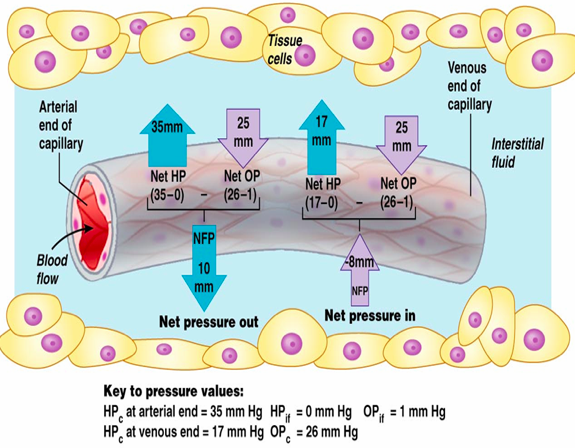Close

1. Draw a labelled diagram showing the anatomy of the microcirculation.
2. Describe the three types of capillaries, continuous, fenestrated and discontinuous, with reference to their structure, distribution and function.
3. Describe how lipid insoluble molecules can move across the capillary endothelium.
4. Draw a labelled diagram showing filtration and reabsorption of fluid along an average capillary.
5. Explain how capillary pressure, plasma colloid osmotic pressure and interstitial colloid osmotic pressure can affect fluid movements between plasma, interstitium and lymph.
6. Know the different causes of oedema and explain the pathophysiology of each.
What are the three layers of the blood vessel wall?
What is the average diameter and wall thickness of a capillary? What are capillaries known as?
What is the order of vasculatures from small arterioles structures?
What is the diameter of small arteries? Terminal arterioles? Capillaries? How long are capillaries?
Which part of the oxygenated blood system receive sympathetic innervation?
What forms the vascular shunt? What regulates flow through capillaries?
What is the basic structure of capillaries?
What are the three different types of capillaries?
Describe continuous capillaries (anatomy and characteristics).
What are the two different types of continuous capillaries?
How do fenestrated capillaries differ from continuous? What is their function and where are they found?
How do sinusoidal/discontinuous capillaries differ from continuous capillaries? What is their function and where are they primarily located?
What are the different types of transport through into the capillary lumen and for what kinds of substances?
What regulates the movement of water across capillary endothelium? What values would you expect at the different ends of the capillary beds?
How is the net filtration calculated?
Using the values described before, what are the net filtration pressures at the arterial and venous end of the capillary bed?

What does the Starling hypothesis state regarding capillaries?
How much plasma passes through the capillaries every day? How much is filtered? What happens to the majority of this?
Describe the three key structural aspects of the lymphatic capillaries?
What are the two possible movements of fluid once it has entered the lymphatics?
How much of the lymph is returned to circulation everyday? What does a disruption of this lead to?
What is oedema?
What are the main types of oedema?
What two things lead to oedema?
What are the four factors which precipitate oedema?
What would cause an increase in capillary hydrostatic pressure?
What can cause plasma oncotic pressure to decrease?
What is Kwashiorkor? How does it lead to oedema? What is the common presentation in children?
Why does increased capillary permeability lead to oedema? How might increased capillary permeability occur?
What conditions might cause obstruction of lymph drainage?
How is oedema treated?

 Hide known cards
Hide known cards